

Mexican scientist cures the Human Papilloma Virus
“…Gallegos has treated hundreds of patients with photodynamic therapy over the last twenty years, studying its effects. Now, she has successfully used this therapy to eradicate HPV in 100% of patients who present without malignant legions, and 64.3% of women with pre-cancerous lesions.
Her discovery will have a huge impact, as most sexually active people will have at least one HPV infection in their lives. Current statistics report that 79 million Americans have HPV, with 14 million new infections each year.
HPV is especially dangerous for women, as it can lead to cervical cancer, which, if left untreated, can cause infertility and death…”
A journalist’s journey, guided by curiosity for her father’s illness
“…Now the story of a daughter who grew up on the border between the United States and Mexico. She searches for herself, while also coming to grips with her father’s mental illness.
Amna Nawaz has the latest selection from the “NewsHour” Bookshelf…”
Link to transcript
3 reasons for the declining number of Latino physicians
The U.S. Hispanic population has seen significant growth (link is external) in past 50 years, so how is it that fewer Latinos are becoming physicians?
Earlier this year, Latino Leaders Magazine reported on this decline (link is external): a 2015 study, conducted by the Center for the Study of Latino Health and Culture (link is external) at UCLA, indicates that the number of Latino physicians dropped 22 percent over a 30-year period.
1980: 135 Latino physicians per 100,000 Latinos
2010: 105 Latino physicians per 100,000 Latinos…
Link to article
This Chicana chemist is paying it forward to support students from underrepresented groups
On a calm September evening in 2010, Alegra Eroy-Reveles had come home from lab and put her toddler to bed when a dear friend called. As they talked, Eroy-Reveles scribbled with a marker on the mirrored closet door, like she did on fume hoods in the chemistry lab where she worked as a postdoc at the University of California (UC), San Francisco. The conversation touched on proteases, probes, experiments that weren’t working, and her disillusionment with the pressure to publish. But it took a turn when the friend said she was dying of breast cancer…
Link to article
Mexican American Women Leaders
YC Leyva, PD Witherspoon – Gender, Communication, and the Leadership Gap, 2017
… data. Garcia and Enriquez emphasized the importance of data, including statistical
information, in building a case for Page 304. Mexican American Women Leaders■
277 solutions in work and professional contexts. However …
Link to book preview
How this grassroots environmental justice hero is leading his hometown resistance
The activist mark! Lopez didn’t attend his first march for environmental justice on foot. He was pushed in a stroller. A winner of this year’s Goldman Environmental Prize for grassroots “heroes”, Lopez has agitated alongside his family since childhood.In the late 1980s, when he was growing up in East Los Angeles, Lopez’s grandparents and others took down a proposed state prison, a toxic waste incinerator, and a pipeline planned to run near a school. The 32-year-old Lopez stepped up to help lead the battle against the Exide battery smelter — a factory just outside East L.A.’s borders that for decades spewed noxious chemicals, like lead and arsenic, into neighboring communities that are mostly inhabited by people of color. Activists in the area fought the company for years — citing public health concerns related to lead contamination, such as impaired neurological development in children and increased violence in exposed communities — and the plant officially closed in 2015. Cleanup, however, for which the state set aside $176.6 million, has barely gotten underway and has already hit roadblocks…
Mexican American Psychology: Social, Cultural and Clinical Perspectives
MA Tovar – 2017 – books.google.com
There are now more than 32 million Mexican Americans living in the United States. As a
result, the odds that a clinician will work with a member of this population—one of the fastest-
growing minority groups in the United States—is extremely high. Understanding the culture…
Link to book preview
How perceptions of an anti-immigrant environment negatively impacts Latino health outcomes
The first 50 days of President Trump’s administration has seen an increase in immigration raids and the rise of hate crimes towards immigrants. This anti-immigrant sentiment is creating fear and stress for immigrants which ultimately lead to negative health outcomes. In our paper recently published in the Journal of Health Politics, Policy and Law we examine how living in an anti-immigrant environment can negatively impact Latina/o health, consistent with recent published research by Dr. Francisco Pedraza. Using nationally representative data from the Latino National Health and Immigration Survey (LNHIS, n=1,493) funded by the RWJF Center for Health Policy at the University of New Mexico and implemented by Latino Decisions, we examine the relationship between Latino’s perceptions of where they live and their self-reported physical health and mental well-being. Our findings show that 38 percent of Latinos perceived their state’s immigrant policies as unfavorable towards immigrants. While this data collection was conducted in 2015, we believe the current political environment will exacerbate health disparities for an entire generation of Latina/o Americans…
Link to article
Alfredo Quinones-Hinojosa, M. D., Mexican American Professional
Alfredo Quiñones-Hinojosa (also known as “Dr. Q”) is a neurosurgeon, author, and researcher. Currently, he is the “William J. and Charles H. Mayo Professor” and Chair of Neurologic Surgery and runs a basic science research lab at the Mayo Clinic Jacksonville in Florida. In recognition of his work, Dr. Quiñones-Hinojosa has received many awards and honors, including being named as one of the 100 most influential Hispanics in the U.S. by Hispanic Business Journal in 2008; as 2014 Neurosurgeon of the Year by Voices Against Brain Cancer, where he was also recognized with the Gary Lichtenstein Humanitarian Award; and by the 2015 Forbes magazine as one of Mexico’s most brilliant minds in the world…
Link to biography
The Role of Ethnicity
Counseling LGBTQI + Person of Color…
Link to chapter preview
Esther Cepeda: Latino health-outreach program is a reminder that it’s all in the name
If culture can be used as a currency to understand and serve a community, it can also be a trap, if the culture is painted with too broad a brush. We think we “know” the so-called Hispanic community — generalizing to certain tropes about language, love of family, deference to authority figures, etc. — and we rarely stop to question whether our initial assessments still hold true.
For instance, a decade ago, the hot medical news was the emerging use of “promotoras” — Spanish-speaking Latina community volunteers who worked with medical organizations to coordinate health outreach activities in their neighborhoods — as a cutting-edge tactic to produce better outcomes in predominantly Mexican populations suffering from obesity, diabetes and other ailments…
Link to article
Mexican American Proarchive: Annual Report on Mexican American Professionals
News from the census American Community Survey is generally good for the 2015 year. Mexican American college enrollment was up from 18.7% to 18.9% in the 2014 and 2015 years. Graduate or professional degree attainment was also up from 2.9% to 3.0%. The number of bachelor’s degrees granted to Mexican American students rose from 7.6% in 2014 to 7.8% in 2015.


In spite of these gains, Mexican Americans still remain at the bottom of the ladder when it comes to earning a bachelor’s degree. Even after broadening the group to Latinos or Hispanics, this group still lags behind. According to the Pew Hispanic Center: “As of 2014, among Hispanics ages 25 to 29, just 15% of Hispanics have a bachelor’s degree or higher. By comparison, among the same age group, about 41% of whites have a bachelor’s degree or higher (as do 22% of blacks and 63% of Asians).” Pew reports that the main reasons for this low graduation rate is that Hispanics are less likely “to enroll in a four-year college, attend an academically selective college and enroll full-time.”
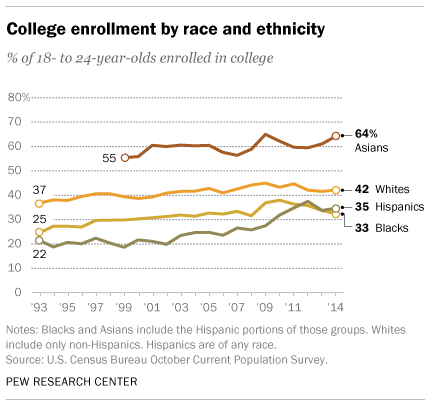
Also in the good news column, the University of California will continue to push for a greater number of underrepresented minorities; namely, Chicano/Latino students whose resident freshmen numbers rose from 2.7% to 32.3% of admitted California freshmen. In other good news, the proportion of Chicano/Latino students transferring from community colleges increased to 29.3% from 26.8% for 2015.
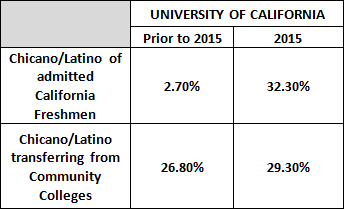
Occupations, including those in management, business, science, and art, fared better for Mexican Americans. The number of Mexican Americans filling these occupations rose from 17.4% in 2014 to 17.5% in 2015.

The total number of Hispanics filling these occupations was 16.1% in 2015, a bit lower than Mexican Americans specifically.
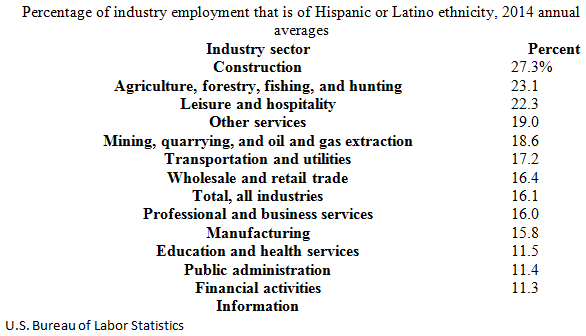
The report shows that industrial employment for Mexican Americans remained the same for 2014 and 2015 at 10.2%.
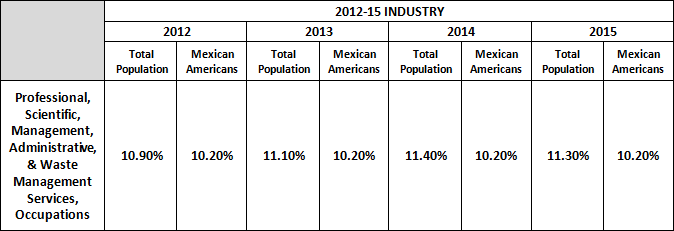
The figures for Hispanic or Latino employment for 2015 and 2016 show a healthy increase.
According to the Pew Hispanic center, “Construction, professional and business services, health services, financial services and food services…showed healthy gains.” Most of the jobs gained by native-born Hispanic workers were in manufacturing, mostly durable goods (82,000 Hispanic workers in this industry), followed by wholesale and retail trade (79,000), publishing, broadcasting, communication and information services (55,000), and construction (54,000).
Foreign-born Hispanics had the most job gains in construction (417,000), followed by business and professional services (179,000). Together, those two industries accounted for almost three-quarters (74%) of all jobs gained by foreign-born Latinos between 2005 and 2006.
The business and professional services sector, which ranges from management and technical services to janitorial, landscaping, and waste management services, is also a key employer for non-Hispanic workers. Of the total increase in employment in 2005-06, non-Hispanic workers accounted for 410,000 employees in the industry, native-born workers 327,000, and foreign-born workers 83,000.
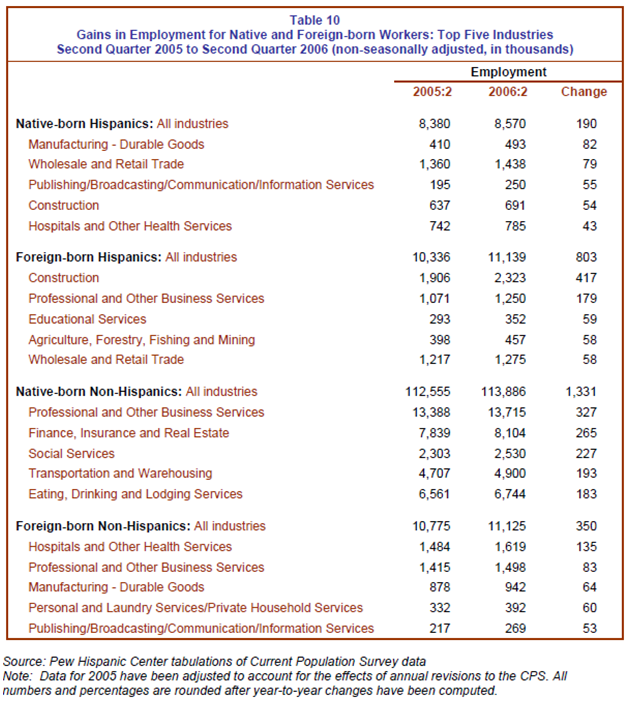
Sources
- Census Bureau, Selected Population Profile in the United States: 2015
- Pew Research Center
- University of California
- Bureau of Labor Statistics
A community in need: Rate of Latino physicians shrinks, even as Latino population swells
By Almendra Carpizo
Record Staff Writer
Celida Lizarraga doesn’t remember seeing many doctors who looked like her when she had to translate for her parents during medical visits.
The 17-year-old said most doctors didn’t speak Spanish and an official interpreter wasn’t always available. And even when interpreters were there, she said, there was disconnect between her parents and the doctor.
“I was the one who my parents relied on,” Lizarraga said.
The group Latino Physicians of California is emphasizing the need for more Latino physicians in the state, where about 40 percent of the population is Latino, but less than 5 percent of doctors are Latino.
During a media phone conference on Friday,…
Link to article
Obama White House Touts Latino Gains in Income, Education, Health
by SUZANNE GAMBOA
WASHINGTON, DC — The White House on Wednesday touted gains Hispanics have made in education, income and health insurance during President Barack Obama’s time in office.
In a report released to mark the closing days of Hispanic Heritage Month, which ends Saturday, the White House issued a four-page brief from its Council on Economic Advisers on the Hispanics’ economic progress in the Obama years.
Obama marked the close of Hispanic Heritage month with remarks at a White House reception Wednesday afternoon. Hispanic Heritage Month began Sept. 15 and closes on Saturday.
“Over the last eight years we have made a lot of progress, together for all Americans and nowhere have you been able to see more vividly the progress than in the Hispanic American community,” Obama said at the event…
Link to article
The Devil is Loose: Drownings, shootings, high-speed accidents, immigrants in labor-the life of a border paramedic
For the paramedics in Laredo, Texas, the only event more concerning than a Dallas Cowboys’ loss is a fight night. Saturday, May 7, the eve of Mother’s Day, was fight night. Throughout the afternoon, the cemeteries were full of people carrying flowers to their mothers’ tombstones, bright tributes laid down in the searing heat. That evening, much of the town gathered around flat screens to watch the Mexican champion Canelo Álvarez and a British contender named Amir Khan slug it out for the middleweight title. Not many were rooting for Khan…
Link to article
The Role of Social Class, Ethnocultural Adaptation, and Masculinity Ideology on Mexican American College Men’s Well-Being
L Ojeda, B Piña-Watson, G Gonzalez – 2016
… More specifically, Latinas are surpassing Latino men, and Mexican Americans overall
are less likely to earn a degree com- pared with other Latino ethnic groups (eg, Puerto
Ricans, Cu- bans; US Census Bureau, 2011). These …
Link to report
EXPLORING THE LIVED EXPERIENCE OF INTIMATE PARTNER VIOLENCE AND SALUTOGENESIS IN AGING MEXICAN – AMERICAN WOMEN
Intimate partner violence, a serious preventable public health problem affects one in three women in the US and a billion women worldwide, crossing all boundaries including age, ethnicity, religion, and socioeconomic. However, little is known about the experience of IPV in aging women, especially in aging ethnic minorities. Furthermore, there are countless hidden victims including the many children who witness repeated IPV, placing them at risk of becoming a victim of IPV or a perpetrator in their own intimate relationships. The purpose of my dissertation was to explore the lived experience of IPV through the lens of aging Mexican-American women with a history of IPV, to increase understanding of how their experience has shaped their lives today, and to identify the salutogenic factors that may have sustained health in the midst of adversity…
Link to dissertation
Intergenerational Influences in Body Image Among Mexican American Obese Adolescent Females and Their Maternal Caregivers: ¿ Llenita no más ?
YA Marroquin
… Grounded Theory and thematic analysis were utilized to examine interview responses from
Mexican and Mexican American adolescent females with obesity, their … family members, peers
and friends, and medical professionals). In addition, the messages …
Link to dissertation
How being a bilingual speaker might make your brain stronger
During a presentation this past weekend at the American Association for the Advancement of Science meeting in Washington, DC, Judith Kroll, a psychologist at Penn State who studies bilingualism, described how speaking both English and Spanish “changes the architecture of your brain,” and that being bilingual could literally making your brain stronger…
Link to article
Writing the Good Life: Mexican American Literature and the Environment
PS Ybarra – 2016
… Writing 3 1 epistemological hierarchy and the environment: erasure of Mexican American
Knowledge in … The professionals at the New Mexico State Archives answered questions before
I … I have met so many colleagues at conferences and through professional organizations …
Link to book preview


